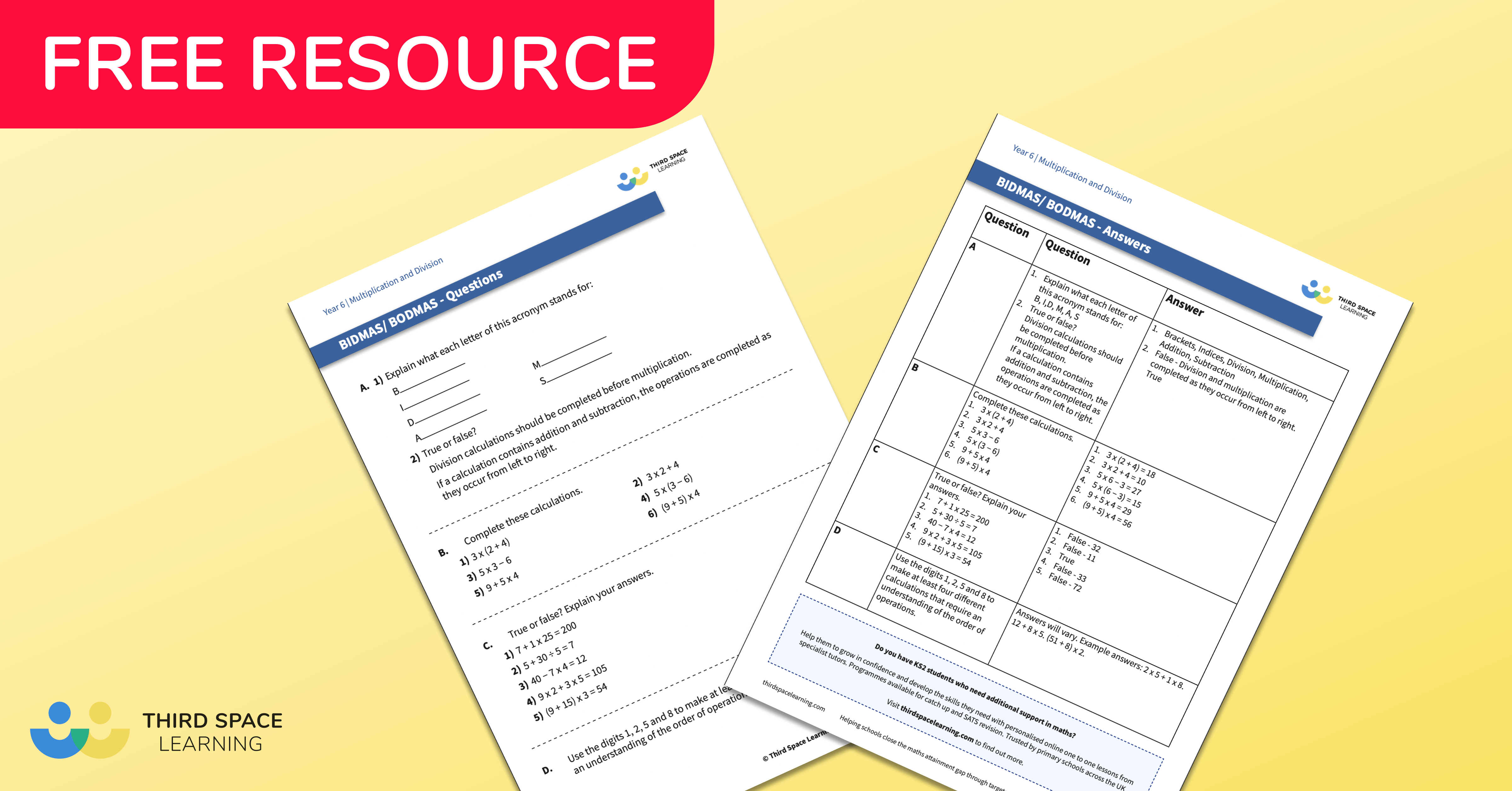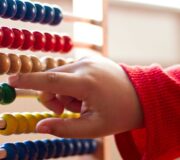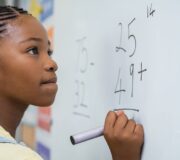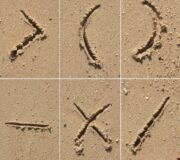What Is BIDMAS: Explained for Primary School
BIDMAS is an acronym that children learn at primary school for the correct order of operations ie in what order they should complete the steps in a calculation. It is often used interchangeably with BODMAS.
What is BIDMAS?
BIDMAS is an acronym to help children remember the order of mathematical operations – the correct order in which to calculate the steps in a maths question. BIDMAS standards for B-Brackets, I-Indices (powers/orders or roots), D-Division, M-Multiplication, A-Addition, S-Subtraction.
What is the BIDMAS rule
The Bidmas rule states that multiplication and division must be done before subtraction and addition in any mathematical example. Brackets (or parentheses) and indices (orders, powers or roots) must be dealt with first. For example in the question 3² – 5 + 3 × 8 the answer is 28.
- 3² – 5 + 3 × 8
- 3² = 9
- 3 x 8 = 24
- Perform the calculation from left to right: 9 – 5 + 24 = 4 + 24 = 28
Year 6 BODMAS Questions Worksheet
Download this free BIDMAS and BODMAS worksheet for your Year 6 class to practice their order of operations skills
Download Free Now!Brackets are also known as parentheses, and indices are also known as exponents or ‘powers of’; because of this, there are a number of different acronyms for the order of operations, such as BEDMAS, BODMAS, PEMDAS or PEDMAS.
BIDMAS examples
Take the calculation 24 – 3 x 5. You would use BIDMAS to solve this by first calculating the multiplication (3 x 5 = 15) and then the subtraction (24 – 15 = 9). Calculating this without BIDMAS and just by going from left to right would give you the wrong answer of 105 (24 – 3 = 21 and 21 x 5 = 105).
Third Space Learning’s online, one-to-one tuition lessons take students through example questions step by step and help to build conceptual understanding. Tailored to the needs of each student, our programmes help to grow skills, fill gaps and grow confidence in maths.
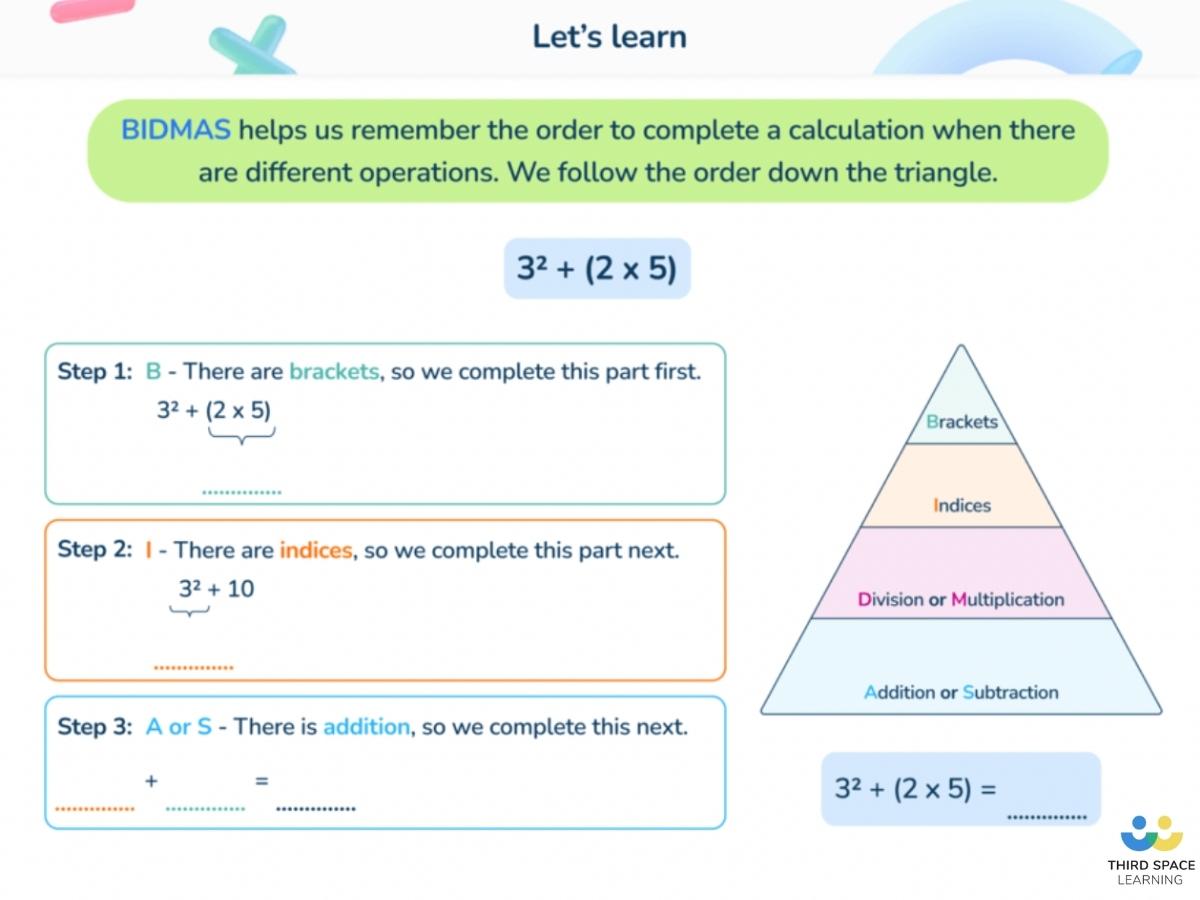
When do children learn about BIDMAS in the national curriculum
Whilst the acronym ‘BIDMAS’ isn’t explicitly referenced in the National Curriculum, it doesn’t require schools to teach the order of operations until Year 6, where “pupils should be taught to use their knowledge of the order of operations to carry out calculations involving the four operations”. There is also non-statutory guidance recommending that “pupils [in Year 6] explore the order of operations using brackets; for example, 2 + 1 x 3 = 5 and (2 + 1) x 3 = 9.”
How does BIDMAS relate to other areas of maths
In algebra in Year 6, there is non-statutory guidance that “pupils should be introduced to the use of symbols and letters to represent variables and unknowns in mathematical situations that they already understand”. This is often through word problems such as the example below, taken from the 2018 SATs paper.
This could be represented as p = 60c + 125, where p = price and c = number of colours. In algebra, a number and a letter together mean they should be multiplied together – so in the example above, as per BIDMAS, the multiplication is completed first (60 x number of colours) before then adding 125 to calculate the price in pennies.
BIDMAS in real life
When having to solve bodmas questions and multi-step mathematical problems in real life, using BIDMAS through the order of operations will usually be relevant. For example, cooking a turkey for 15 minutes plus 20 minutes per kilogram would require the multiplication to be calculated first (20 x number of kilograms) and the addition after (adding 15 minutes to the final amount).
3 worked examples for BIDMAS
1. Write the missing number: 48 ÷ (19 – __) = 4
As per the rules of BIDMAS, the division must be calculated first. Without the brackets, we are left with 48 ÷ ___ = 4, so the missing number here is 12. As calculation inside the brackets must equals 12 (19 – __), that means the missing number is 7.
2. 4 x (2 + 7) ÷ 2 =
As per the rules of BIDMAS, the calculation inside the brackets must be completed first which leaves us with 4 x 9 ÷ 2. As multiplication and division are of equal priority, it doesn’t matter which operation is completed first as both ways will achieve the correct answer. 4 x 9 = 36 and 36÷ 2 = 18 OR 9 ÷ 2 = 4.5 and 4 x 4.5 = 18.
3. Insert a pair of brackets to make this calculation correct: 20 – 5 x 3 + 2 = 47
As the multiplication already takes precedence over addition or subtraction, it would be unnecessary to put any brackets around the multiplication. This means the brackets would either go around the first pair of numbers or the last pair. The answer is (20 – 5) x 3 + 2 as that results in 15 x 3 + 2 = 45 + 2 which is 47.
5 BIDMAS practice questions and answers
- (__÷__) + 90 = 100
Answer: any two numbers with a quotient of 10, like 20 and 2, or 50 and 5. - 30 – 6 x 2
Answer: 18 - Put brackets into this expression to make it correct: 102 ÷ 10 ÷ 10 ÷ 10 ÷ 10 = 100
There are many different answers to this:
102 ÷ (10 ÷ 10) ÷ (10 ÷ 10) = 100
- or 102 ÷[(10 ÷ 10) ÷ 10)] ÷ 10 = 100
- or (102 ÷ 10) ÷ [(10 ÷ 10) ÷ 10] = 100
- or 102 ÷ {10 ÷ [10 ÷ (10 ÷ 10)]} = 100
- or 102 ÷ [10 ÷ (10 ÷ 10) ÷ 10] = 100
- or 102 ÷ [10 ÷ 10 ÷ (10 ÷ 10)] = 100
- 50 – 33 + 9
Answer: 32
- Insert the operation which makes this calculation correct: 18 __ 3 x 5 = 30
Answer: ÷
DO YOU HAVE STUDENTS WHO NEED MORE SUPPORT IN MATHS?
Every week Third Space Learning’s maths specialist tutors support thousands of students across hundreds of schools with weekly online maths tuition designed to plug gaps and boost progress.
Since 2013 these personalised one to one lessons have helped over 150,000 primary and secondary students become more confident, able mathematicians.
Learn about the scaffolded lesson content or request a personalised quote for your school to speak to us about your school’s needs and how we can help.

